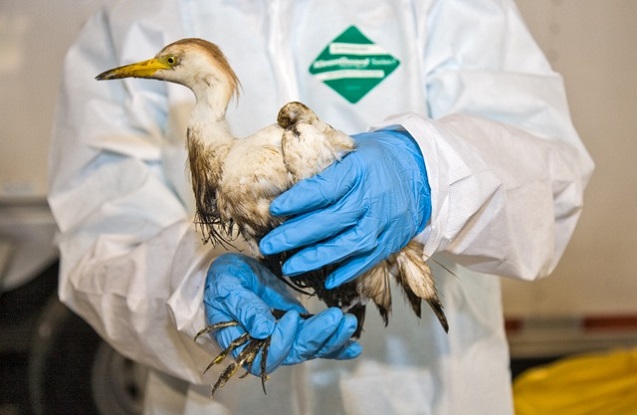
Heavy fuel oil that spilled from a Kirby Inland Marine oil barge after it collided with a cargo ship on March 22, began washing up on Galveston Bay’s shoreline on Sunday. The Coast Guard received its first reports of impacted birds by Sunday afternoon and the Houston Chronicle published a photo of a duck on the beach covered in oil.
There are shorebird habitats on both sides of the shipping channel, including the Bolivar Flats Shorebird Sanctuary.
Richard Gibbons, conservation director of the Houston Audubon Society, told the Associated Press that the Bolivar Flats Shorebird Sanctuary attracts 50,000 to 70,000 shorebirds to its shallow mud flats perfect for foraging.
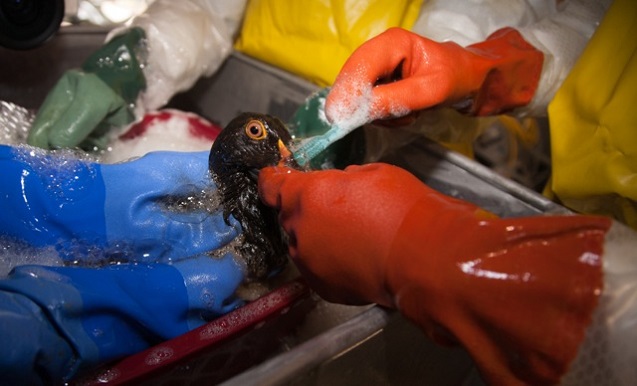 © 2010 Julie Dermansky)” width=”637″ height=”386″ />Staff of the Wildlife Center of Texas cleaning oil covered wood duck rescued after an oil spill in the Mississippi River in August 2008. (Photo: © 2010 Julie Dermansky)
© 2010 Julie Dermansky)” width=”637″ height=”386″ />Staff of the Wildlife Center of Texas cleaning oil covered wood duck rescued after an oil spill in the Mississippi River in August 2008. (Photo: © 2010 Julie Dermansky)
“The timing really couldn’t be much worse since we’re approaching the peak shorebird migration season,” Gibbons said. He added that tens of thousands of wintering birds remain in the area.
Officials report that so far fewer than 10 impacted birds were sighted and recovered for transfer to a wildlife rehabilitation facility established by the Unified Command. Wildlife Response Services, a Texas-based wildlife rehabilitation service, was tapped to treat affected birds and marine life. The Wildlife Center of Texas is on standby to help. They cleaned birds in Louisiana following a spill on the Mississippi River in 2008.
The oil spill continued to unfold on Monday, the 25th anniversary of the Exxon Valdez oil spill in Alaska. The Valdez spilled close to 11 million gallons of heavy black crude. Negative impacts from the spill are still felt, with only 13 of the 32 monitored wildlife populations, habitats and resource services injured in the spill listed as fully “recovered” or “very likely recovered.”
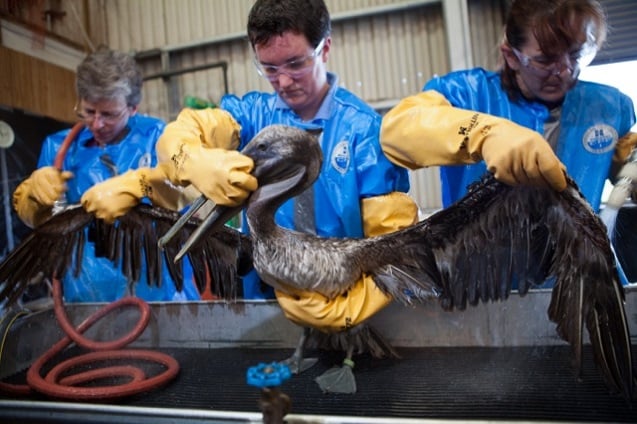 © 2010 Julie Dermansky)” width=”637″ height=”424″ />An adult brown pelican covered with BP oil found on Grande Isle, Louisiana, cleaned by a team from Tri-State Bird Rescue & Research. (Photo: © 2010 Julie Dermansky)
© 2010 Julie Dermansky)” width=”637″ height=”424″ />An adult brown pelican covered with BP oil found on Grande Isle, Louisiana, cleaned by a team from Tri-State Bird Rescue & Research. (Photo: © 2010 Julie Dermansky)
The oil barge spill occurred the day before another somber anniversary — that of the 2005 BP plant explosion in Texas City, which took place not far from the accident in the shipping channel. Fifteen people died and 170 were injured in that disaster.
The barge was carrying close to a million gallons of oil, according to the Coast Guard’s joint command center. However, only one tanker containing 168,000 gallons was punctured. Reports said the remaining oil had been extracted from the sunken vessel by Sunday evening.
Though only a portion of the oil on the barge spilled, Coast Guard port captain Brian Penoyer describes it as “a significant spill,” and notes that oil residue has been spotted as far as 12 miles out into the Gulf of Mexico.
Unified Command reports: “More than 69,000 feet of containment boom has now been deployed on waters surrounding the incident site and along sensitive shorelines in the area. An additional 141,000 feet of boom has been staged for possible deployment.”
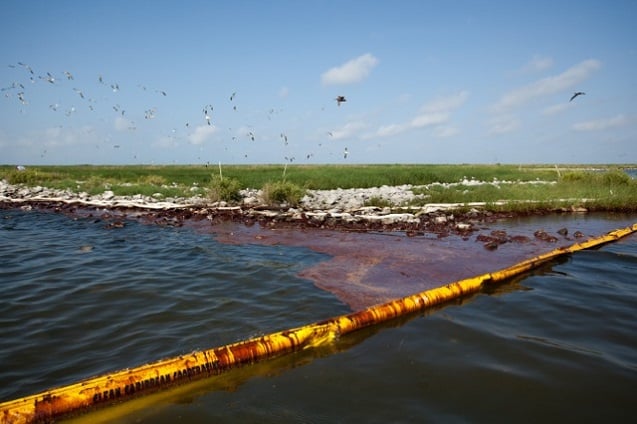 © 2010 Julie Dermansky)” width=”637″ height=”424″ />Queen Bess Island, Louisiana, a rookery for brown pelicans and other migratory birds, is contaminated with BP oil that passed under the boom placed around the island in 2010. (Photo: © 2010 Julie Dermansky)
© 2010 Julie Dermansky)” width=”637″ height=”424″ />Queen Bess Island, Louisiana, a rookery for brown pelicans and other migratory birds, is contaminated with BP oil that passed under the boom placed around the island in 2010. (Photo: © 2010 Julie Dermansky)
But booms deployed after an oil spill do nothing to assure birds’ safety. Oil can pass under booms and pool up in areas trapped between the boom and the coast. A USA Today video shows the oil doing exactly that.
P.J. Hahn, director of coastal zone management for Plaquemines Parish, La., rescued oiled birds during the BP oil spill and witnessed the imminent death of many others. He continues to monitor the barrier islands in Plaquemines that were soiled with oil. One of those islands is Cat Island, a bird rookery. Before the spill, the island was about seven acres and covered with nesting birds. Now the island is almost completely underwater at high tide, only recognizable by the dead branches of what remains of some mango trees.
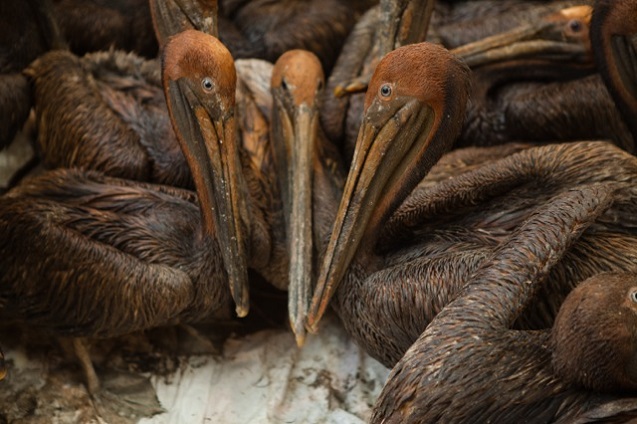 © 2010 Julie Dermansky)” width=”637″ height=”424″ />BP Oil-covered pelicans in a crate waiting to be cleaned at Fort Jackson in Louisiana. (Photo: © 2010 Julie Dermansky)
© 2010 Julie Dermansky)” width=”637″ height=”424″ />BP Oil-covered pelicans in a crate waiting to be cleaned at Fort Jackson in Louisiana. (Photo: © 2010 Julie Dermansky)
Hahn told DeSmog Blog he doesn’t know where the birds are nesting now since so many of the other barrier islands impacted by the oil spill have also eroded.
“The coast is dynamic, so just throwing a boom around an area is not the answer,” Hahn told DeSmog Blog. “Protecting birds is difficult, especially during this time of year. Nesting birds return from feeding in the area and generally get some type of oiling. They then return to their nests and transfer that oil to the chicks or eggs.”
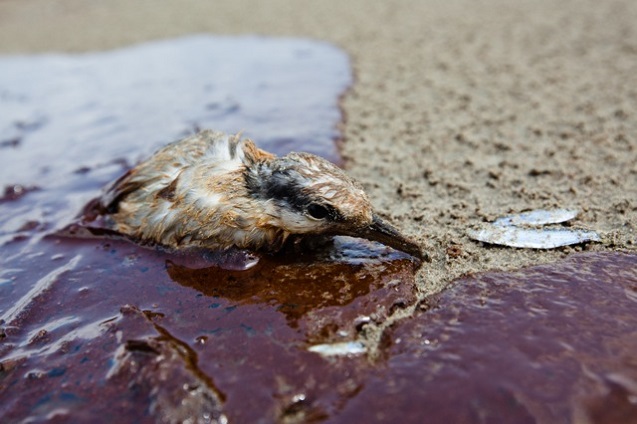 © 2010 Julie Dermansky)” width=”637″ height=”424″ />Baby tern stuck in BP oil on Grand Isle, Louisiana, with fish left for it by its mother. (Photo: © 2010 Julie Dermansky)
© 2010 Julie Dermansky)” width=”637″ height=”424″ />Baby tern stuck in BP oil on Grand Isle, Louisiana, with fish left for it by its mother. (Photo: © 2010 Julie Dermansky)
The Associated Press reports that Jim Suydam, spokesman for the Texas General Land Office, described the type of oil the barge was carrying as “sticky, gooey, thick, tarry stuff.”
“That stuff is terrible to have to clean up,” Suydam said.
The shipping channel is closed while crews try to mount a response to the spill. According to Reuters, the channel delivers crude to a tenth of the nation’s refining capacity. Closing the channel could affect business for half a dozen refineries in Houston and Texas City. Cruise ships were also trapped by the spill. Commerce, however, will return to normal long before the life of the shorebirds does.
Help us Prepare for Trump’s Day One
Trump is busy getting ready for Day One of his presidency – but so is Truthout.
Trump has made it no secret that he is planning a demolition-style attack on both specific communities and democracy as a whole, beginning on his first day in office. With over 25 executive orders and directives queued up for January 20, he’s promised to “launch the largest deportation program in American history,” roll back anti-discrimination protections for transgender students, and implement a “drill, drill, drill” approach to ramp up oil and gas extraction.
Organizations like Truthout are also being threatened by legislation like HR 9495, the “nonprofit killer bill” that would allow the Treasury Secretary to declare any nonprofit a “terrorist-supporting organization” and strip its tax-exempt status without due process. Progressive media like Truthout that has courageously focused on reporting on Israel’s genocide in Gaza are in the bill’s crosshairs.
As journalists, we have a responsibility to look at hard realities and communicate them to you. We hope that you, like us, can use this information to prepare for what’s to come.
And if you feel uncertain about what to do in the face of a second Trump administration, we invite you to be an indispensable part of Truthout’s preparations.
In addition to covering the widespread onslaught of draconian policy, we’re shoring up our resources for what might come next for progressive media: bad-faith lawsuits from far-right ghouls, legislation that seeks to strip us of our ability to receive tax-deductible donations, and further throttling of our reach on social media platforms owned by Trump’s sycophants.
We’re preparing right now for Trump’s Day One: building a brave coalition of movement media; reaching out to the activists, academics, and thinkers we trust to shine a light on the inner workings of authoritarianism; and planning to use journalism as a tool to equip movements to protect the people, lands, and principles most vulnerable to Trump’s destruction.
We’re asking all of our readers to start a monthly donation or make a one-time donation – as a commitment to stand with us on day one of Trump’s presidency, and every day after that, as we produce journalism that combats authoritarianism, censorship, injustice, and misinformation. You’re an essential part of our future – please join the movement by making a tax-deductible donation today.
If you have the means to make a substantial gift, please dig deep during this critical time!
With gratitude and resolve,
Maya, Negin, Saima, and Ziggy